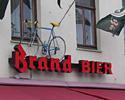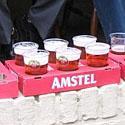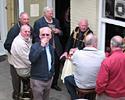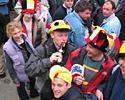
Recently on Cyclingnews.com |
Tales from the (European) peloton, April 18, 2004
The Anthropology of Fanaticism
A multicultural study of wheel-lovers
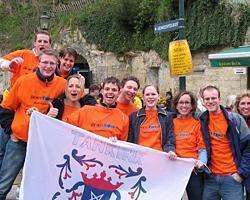
|
As any European knows, Europe grows up with cycling. Each year, as the Spring Classics speed through small towns in small countries, kids, families, and drunken alike take a small step away from their daily routines to cheer on their local heroes. Ella Lawrence goes with the local flow on a day out at the Amstel Gold.
Maastricht, the capital of Limburg and the site of the Amstel Gold race, sits exactly between the Netherlands, Germany, and Belgium. It's a good place to study the different characteristics of fans from different countries.
At 9:30am, before the start, the busiest place in Maastricht's Markt Square is the space surrounding the team buses, which are parked like giant caterpillars in the middle of the square. The one with the most action surrounding it is the CSC bus, probably because all of the riders are still inside. Their shiny black and red Cervelos are lined up in a perfect row on the side of the bus, and Danish families with small flags affixed to their backpacks wait for a chance to get baseball caps autographed. Old men in wool jerseys on steel bikes with downtube shifters stand toward the back of the crowd, gossiping amongst themselves about past races and today's possible winner (Michael Boogerd of Rabobank is the favorite), but while they are interested in the shiny bikes and the gleaming, muscular racers, they've seen it all before and would rather relive their own glory days.
The riders emerge, and the Danish fans cheer, pumping up their boys at the start. A couple of American students have pushed their way to the front of the group and are excitedly snapping photos of the pros up close.
|
|
|
|
|
One fan quips excitedly, "I came to the Netherlands to study partly because I wanted to see some real races. Racing in America is so different. You could never get close to the buses or the racers like this! Security has everything roped off so tightly. Here, the fans are an integrated part of the race."
Pro races on America's West Coast, like the San Francisco Grand Prix or the Sea Otter Classic, where vendors and yuppies converge to sip Starbucks lattes and buy next year's fastest wheelset, are a far cry from the scene today. Here in the Netherlands, cycling is about camaraderie and competition.
At the start line, the younger fans are excited, chattering amongst themselves and jumping up to catch a glimpse riders behind the lead motorcycles as they wait for the riders to roll out. The older fans, mostly Dutch men in their mid-fifties, sit staidly drinking their beers at 10am. They've seen it before and sagely contemplate the scene from terrace cafes. Later, toward lunchtime, a hike up the 'hill' (the Netherlands is the flattest country in the world, after all) the peloton will climb three times during the race provides a larger group of fans to study. By now, everything is accompanied by the inevitable corny techno music that is a cross-cultural phenomenon at any bike race, blaring through speakers mounted on trees to pump up the fans for their favorite riders.
French fans converge, wearing expensive Rudy Projects and smoking cigarettes, talking importantly about relevant race tactics. The Dutch are the most prominent group today, of course, although most Dutch fans readily cede that Belgian fans are the wildest by far.
"They're definitely the craziest cycling fans," admits a Dutch fellow in a Rabobank cycling cap. "All of their TV stations cover the races live, they've got these giant flags all the time, they just go nuts. You should see them when the race is in Belgium!"
A not-so-wild Belgian family occupies a spot on a low wall underneath their giant flag. They're picnicking, bringing their kids up in true Belgian tradition - at a bike race. A Dutch cameraman scratches his head perplexed and says that the Belgians, and their flags, have been at the finish line since 8:30 this morning. Indeed, the best spots in front of the big-screen TV suspended from an ancient stone bridge are occupied by Flemish groups clustered under their yellow flag with its emblazoned black lion. They loudly cheer on their darlings, quaffing beer brought from home - the best in the world, they say.
|
|
|
|
|
|
|
Dutch spectators are growing more jovial by the minute as the cardboard trays of Amstel 'fluitjes' (little flues of beer) are carried out by the dozen. Groups of younger fans in orange T-shirts fight for the camera's attention, singing sentimental nationalistic songs at the top of their lungs.
The stacks of empty plastic cups on terrace tables grow higher as the cheering and singing grow louder, still a full half-hour before the racers are to climb the Valkenburg.
The crowd becomes more excited as the announcer's tone picks up, their voices raised, talking faster. The riders will come by in a mere ten minutes and the crowd can feel their proximity. A T-Mobile support car speeds by, flinging pink inflatable hands to the crowd, as the tiny local speed-limit recorder blinks "You are driving too fast". The motorcycles with their flashing lights arrive, and two riders follow them up the mountain, eight minutes off the front. Everyone cheers politely, but what the crowd really wants is the peloton. As the blur of color passes inches in front of their noses, the fans go wild, screaming for their favorites, their countrymen. When the excitement is over, two minutes later, the fans get back to the serious business of drinking.
The race would not pass through Valkenburg for another two hours, at the finish. While some fans followed the race in their cars, most of the action stayed in Valkenburg, where the taverns and terraces fill rapidly with groups of fans shouting at televisions that were showing the race in every smoky corner. On an open terrace, a group of German-speaking Belgians from the French-speaking part of the country kindly shared the stacks of ponchos they'd collected from yet another vehicle (this time a race-sponsor) slinging schwag. The yellow monstrosities were donned, the fans glad for the non-breathable warmth as raindrops start to come down all of a sudden out of clear blue sky, holding true to the schizophrenic Netherlands weather patterns.
The crowd at the finish line is smaller than the pub crowds. Only the die-hard cyclist fans are left, mostly Dutch and Belgians. The rest of the fans have tired themselves out from five hours' steady drinking, and they rest below umbrellas or in pubs, content to watch the finish from the screens. I, however, push my way to the barriers just in time to see the two riders off the front as they pass the 200 metres to go line. I'm close enough to see the sweat dripping off Boogerd's face as he bites his tongue, probably regretting his early attack as Rebellin pulls around him at the 100 metre mark to take the win.
The fans quickly dissemble their makeshift camps and heads back to their cars. This race is, after all, just a normal course of a European spring. Riding a clunky borrowed Dutch cruiser back to Maastricht, I made better time than the Fassa Bortolo bus, which trundled along the street, a few feet from my side. The still-spandexed riders inside looked tired, sweaty, and most of all, human. The glory and the heroism have faded, and they will go home to rest and prepare for another day at work, just like their fans.
Photography
Images by Ella Lawrence
- One fully-equipped CSC fan.
- The bikes are there, but where are the riders.
- Starting 'em young.
- Out come the CSC riders from the team bus.
- The race motorcade all 30 of them.
- Almost everyone's got a race radio nowadays.
- Wouldn't mind that as a souvenir!
- Alexandre Vinokourov (T-Mobile) appears oblivious to all the attention.
- And they're off!
- The riders make their way out of Maastricht.
- Beer and bikes go hand-in-hand around this neck of the woods.
- The Bram Tankink fan club.
- Standard-issue provisions for European cycling fans.
- And don't they love it, too!
- The older men, many of them former cyclists, talk about the good 'ol days.
- Things start to get a tad rowdy.
- The peloton is near on the Valkenburg...
- An early casualty.
- Here they come...
- Everyb-o-d-y, clap your hands.
- No prizes guessing where these fans are from.
- The Flandrian flags are never too far away.
Other Cyclingnews interviews Full Amstel Gold Race coverage


